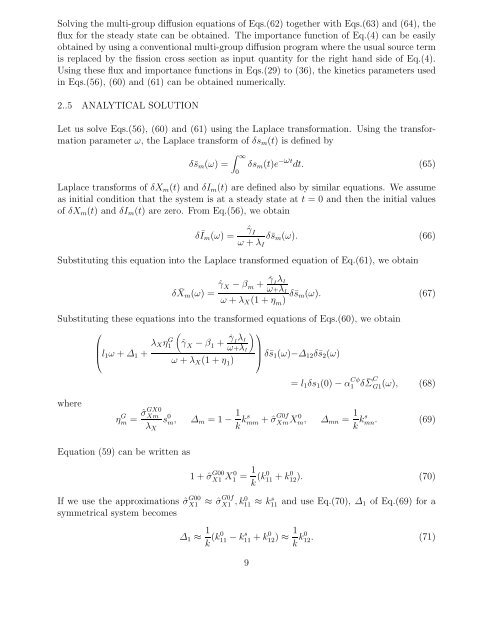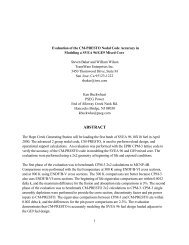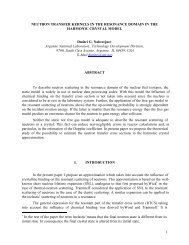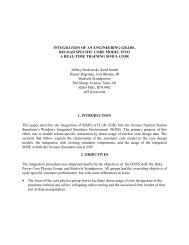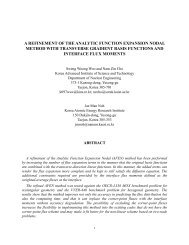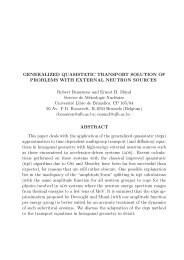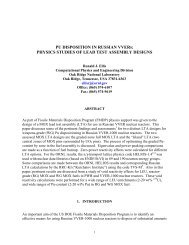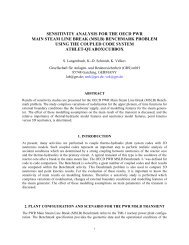K. Kobayashi and S. Tsumura
K. Kobayashi and S. Tsumura
K. Kobayashi and S. Tsumura
You also want an ePaper? Increase the reach of your titles
YUMPU automatically turns print PDFs into web optimized ePapers that Google loves.
Solving the multi-group diffusion equations of Eqs.(62) together with Eqs.(63) <strong>and</strong> (64), the<br />
flux for the steady state can be obtained. The importance function of Eq.(4) can be easily<br />
obtained by using a conventional multi-group diffusion program where the usual source term<br />
is replaced by the fission cross section as input quantity for the right h<strong>and</strong> side of Eq.(4).<br />
Using these flux <strong>and</strong> importance functions in Eqs.(29) to (36), the kinetics parameters used<br />
in Eqs.(56), (60) <strong>and</strong> (61) can be obtained numerically.<br />
2..5 ANALYTICAL SOLUTION<br />
Let us solve Eqs.(56), (60) <strong>and</strong> (61) using the Laplace transformation. Using the transformation<br />
parameter ω, the Laplace transform of δsm(t) is defined by<br />
δ¯sm(ω) =<br />
∞<br />
0<br />
δsm(t)e −ωt dt. (65)<br />
Laplace transforms of δXm(t) <strong>and</strong> δIm(t) are defined also by similar equations. We assume<br />
as initial condition that the system is at a steady state at t = 0 <strong>and</strong> then the initial values<br />
of δXm(t) <strong>and</strong> δIm(t) are zero. From Eq.(56), we obtain<br />
δĪm(ω) = ˆγ I<br />
δ¯sm(ω).<br />
ω + λI<br />
(66)<br />
Substituting this equation into the Laplace transformed equation of Eq.(61), we obtain<br />
δ ¯ Xm(ω) = ˆγ X − β m + ˆγ IλI<br />
ω+λI<br />
ω + λX(1 + η m) δ¯sm(ω). (67)<br />
Substituting these equations into the transformed equations of Eqs.(60), we obtain<br />
⎛<br />
⎜<br />
⎝l1ω λXη<br />
+ ∆1 +<br />
G <br />
1 ˆγ X − β1 + ˆγ<br />
⎞<br />
IλI<br />
ω+λI ⎟<br />
ω + λX(1 + η<br />
⎠<br />
1)<br />
δ¯s1(ω)−∆12δ¯s2(ω)<br />
where<br />
= l1δs1(0) − α Cφ<br />
1 δ ¯ Σ C<br />
G1 (ω), (68)<br />
η G m = ˆσGX0 Xm<br />
s<br />
λX<br />
0 m, ∆m =1− 1<br />
k ks mm +ˆσ G0f<br />
XmX 0 m, ∆mn = 1<br />
k ks mn. (69)<br />
Equation (59) can be written as<br />
If we use the approximations ˆσ G00<br />
X1<br />
symmetrical system becomes<br />
1+ˆσ G00<br />
X1 X0 1<br />
1<br />
=<br />
k (k0 11 + k0 12 ). (70)<br />
≈ ˆσG0f<br />
X1 ,k0 11 ≈ ks 11 <strong>and</strong> use Eq.(70), ∆1 of Eq.(69) for a<br />
∆1 ≈ 1<br />
k (k0 11 − ks 11 + k0 1<br />
12 ) ≈<br />
k k0 12 . (71)<br />
9


